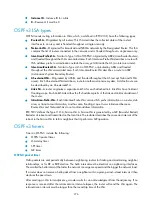
283
Step Command
Remarks
1.
Enter system view.
system-view
N/A
2.
Enter OSPFv3 view.
ospfv3
[
process-id
]
N/A
3.
Configure a bandwidth
reference value.
bandwidth-reference
value
Optional.
100 Mbps by default.
Configuring the maximum number of OSPFv3 ECMP routes
Perform this task to implement load sharing over ECMP routes.
To configure the maximum number of ECMP routes:
Step Command
Remarks
1.
Enter system view.
system-view
N/A
2.
Enter OSPFv3 view.
ospfv3
[
process-id
]
N/A
3.
Specify the maximum number
of ECMP routes.
maximum load-balancing
maximum
Optional.
8 by default.
Configuring a priority for OSPFv3
A router may run multiple routing protocols. The system assigns a priority to each protocol. When these
routing protocols find the same route, the route found by the protocol with the highest priority is selected.
To configure a priority for OSPFv3:
Step Command
Remarks
1.
Enter system view.
system-view
N/A
2.
Enter OSPFv3 view.
ospfv3
[
process-id
] N/A
3.
Configure a priority for
OSPFv3.
preference
[
ase
] [
route-policy
route-policy-name
]
preference
Optional.
By default, the priority of OSPFv3 internal
routes is 10, and priority of OSPFv3
external routes is 150.
Configuring OSPFv3 route redistribution
Follow these guidelines when you configure OSPFv3 route redistribution:
•
Executing the
import-route
or
default-route-advertise
command on a router makes it become an
ASBR.
•
You can only inject and advertise a default route using the
default-route-advertise
command.
•
Because OSPFv3 is a link state routing protocol, it cannot directly filter LSAs to be advertised. You
must filter redistributed routes first. Routes that are not filtered out can be advertised in LSAs into the
routing domain.






























